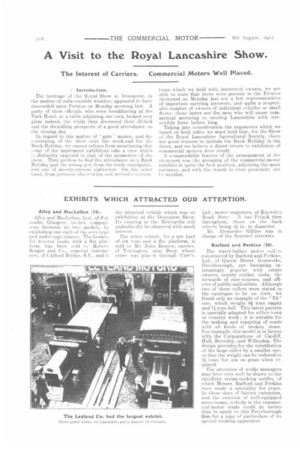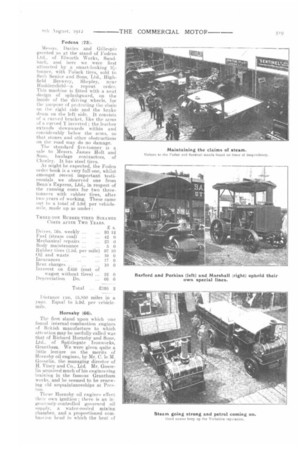EXHIBITS WHICH ATTRACTED OUR ATTENTION.
Page 14

Page 15

Page 16

If you've noticed an error in this article please click here to report it so we can fix it.
Alley and MacLellan (75).
Alley and MacLellan, Ltd., of PolIliadic,. Glasgow, invites comparisons between its two models, by exhibiting one each of lire over-type and under-type classes. The former, for Jive-ton loads, with a flat Oatform, has been sold to Messrs. Seager and Co., removal contractors, of Catford Bridge. S.E., and is the identical vehicle which was on exhibition at the Doncaster Show. Its running in the Metropolis will undoubtedly be observed with much int erest.
The other vehicle, for a net load of six tons and a flat platform, is sold to Mr. John Benson, carrier, of Tottington, near Bury, whose order was pine 'd through Carr's,
Ltd., motor engineers, of Knowsley
Road, Bury. Ti liars Polack tires throughout, those on the back wheels being 42 in. in diameter.
Mr. Alexander Gillies was in charge of the Sentinel interests.
Barford arid Perkins (70).
The water-ballast motor yolk t.'; constructed by Barford and Perkins, Ltd., of Queen Street Ironworks, Peterborough, are becoming increasingly popular with estate owners, county cricket clubs, the stewards of race-courses, and officers of public authorities. Although two of these rollers were stated in the catalogue to be on view, we found only an example of the " E2 " size, which weighs 61/ tons empty and 7-i tons full. This latest pattern is specially adapted for either town or country work ; it is suitable for the making and repairing of roads with all kinds of broken stone. For example, this model is in favour with the Corporations of Cardiff, Hull, Beverley, and Willesden. The design provides for the substitution of the large roller by a smaller one,. so that the weight can be reduced to 3Atons, for use on grass when required.
The attention of works managers may here very well be drawn to the excellent steam-cooking outfits, of which Messrs. Barford and Perkins have made a speciality for years. In these days Of factory extension, and the erection of well-equipped mess-rooms, nobody in the commercial motor trade could do better than to apply to this Peterborough firm for a copy of particulars of its s.,pecial cooking apparatus. Fodens (73).
Messrs. Davies and Gillespie greeted us at the stand of Fodens Ltd., of Elworth Works, Sandbach, and here we were first attracted by a. smart-looking 31,tonner, with Polack tires, sold to Seth Senior and Sons, Ltd., Highfield Brewery, Shepley, near Huddersfield—a repeat order. This machine is fitted with a neat design of splashguard, on the inside of the driving wheels, for the purpose of prAecting the chain on the right. side and the brake drum on the left side. It consists of a cured bracket, like the arms of a curved Y inverted ; the leather extends downwards within and considerably below the arms, so that stones and other obstructions on the road may do no damage.
The standard five-tonner is a sale to Messrs. James Holt and Sons, haulage contractors, of Chorley. It has steel tires.
As might be expected, the Foden order book is a very full one, whilst amongst recent important testimonials we observed one from Bean's Express, Ltd., in respect of the running costs for two threetonners with rubber tires, after two years of working. These came out. to a total of 5.9d. per vehiclemile, made up as under : Hornsby (66).
The first stand upon which one found internal-combustion engines of British manufacture to which attention may be usefully called was that of Richard Hornsby and Sons, Ltd., of Spittlegate Ironworks, Grantham. We were given quite a little lecture on the merits of Hornsby oil engines, by Mr. C. le, M. Gosselin, the managing director of H. Viney and Co., Ltd. Mr. Gosselin acquired much of his engineering training in the famous Grantham works, and he seemed to be renewing old aequaintanceships at Preston.
Those Hornsby oil engines effect their own ignition ; there is an ingeniously-controlled governed oil supply, a water-cooled mixing chamber, and a proportioned combustion head in which the heat of compression causes self-ignition and explosion of the gases. The engines run remarkably quietly ; they are compactly built, of excellent materials and good finish.
In the portable form, a standard engine is mounted on a strong frame, consisting of timber baulks and cross-pieces bolted together with swivelling fore-carriage and east-iron travelling wheels. In the sizes of 1 h.p. to 4 h.p. inclusive, a draw-bar handle is attached, and single-horse shafts on the 5 h.p. and
h.p. sizes. There is an efficient water-cooling system, with circulating pump.
Leyland (76).
Ala Colin S. Percy, at the stand of Leyland Motors, Ltd., appeared to be in his element. It took us some minutes to tear ourselves away beyond earshot of his ready flow of reasons for the purchase of a live-ton petrol lorry by a wellknown carrier from Bury—to wit. Mr. John Eastharn. Shortly afterwards, from Mr. Eastham's own lips, we learnt that he had duly placed the order, and that previously he had been a staunch adherent of steam only.
The Leyland one-tonner is practically a, miniature of the 3i-tou model upon which the company's chief successes in the world of petrol vehicle construction have been built up, except that the reduction to the back axle is of the single-spur type, with bevel final drive in place of worm. The doublespur reduction, which one finds in the larger models, is not employed. This new one-tonner has a 14-16 h.p. Aster engine, and is undoubtedly a machine which should last in hard service. It is a commercial vehicle in the truest sense of the word, yet
not too heavy. The one on view is now the property of the Darwen Industrial Co-operative Society, Ltd., and it has Shrewsbury and Challiner tires throughout. The two five-tonners, each fitted with a 40 h.p. engine, are remarkable for the fact that both are intended for use by old-established Lancashire carriers in two principal ways—for ordinary goods haulage and for char-a-bancs work, To meet the latter requirement, and to overcome the necessary stiffness of the back springs under the lesser imposed load, an interesting system of supplementary springing is now standardized.
The five-toniaer for C. T. Faulkner and Co., Ltd., of Manchester, is fitted with Continental tires throughout, and the five-tonner for Joseph Nall and Co., Ltd., of Manchester, with Dunlop tires. The fourth exhibit on this stand was a five-ton steam wagon, fitted with tipping gears and Colonial wheels—a repeat order for the Municipality of Colombo.
Marshall (72).
At Messrs. Marshall's stand, we again had the pleasure of examining the company's 30 h.p. oil tractor. The average consumption with this machine, for haulage work, is three-tenths of a pint per gross ton-mile, and this economy in operation led us to look somewhat closely into the design of carburetter which the makers have evolved at the Gainsborough works.
Contrary to common belief, there is found to be no occasion to heat the paraffin fuel above a temperature of about 100 degrees Fahrenheit, and it has been established in practice that the cooler it is possible to keep the induction pipe the better, when running on paraffin. After starting up on petrol, the change-over to paraffin is effected without stopping the engine, directly from the driver's seat, and provision is also made for the introduction of a measured supply of water into the main-air supply pipe, on the side of the carburetter remote from the engine. This arrangement, which is the outcome of extensive practical trial at the Marshall works and in everyday use, is found to result in great economy of running, to allow the introduction of the maximum charge per suction stroke, and to prevent pre-ignition. There is no float or moving part in the carburetter casting.
We learnt that, apart from the extensive and world-wide demand for these tractors for agricultural and like purposes, there is evidence of a demand springing up for their use in the United Kingdom for ordinary haulage work. The makers are quite ready to modify this machine, as may be required by customers, to suit town haulage, and they appear to be contemplating a challenge with it to the steam tractor, for which course they find ample justification in the successful challenge of the steam lorry by the petrol lorry.
Mr. j. B. Prosser, the company's oil-tractor expert, and Mr. Henry Burton, the company's Liverpool representative, were in charge of the stand.
Yorkshire (77).
The Yorkshire Commercial Motor Co.'s stand contained three exhibits: two vehicles were steamdriven, and one petrol-driven. One of the former is part of an order from the Mersey Docks and Harbour Board, for three Yorkshire sixtonners. It was shown with a 1000gallon interchangeable watering tank in position, but the complete order includes three wagon bodies and two tank bodies. The six-ton tipping wagon, with mechanicallyoperated gear, constructed to the order of the gas department of the Stockport Corporation, and the company's 30-cwt. petrol lorry, completed an excellent stand. Mr. Robertson and Mr. Pickering were in charge.
General.
We noticed that considerable interest was also taken in the various types of petrol and oil engines that were exhibited on the Bentall, Blackstone, International Harvester, Lister, and Walsh and Clarke stands. Inquirers for light vans showed more than passing interest in the Flanders vehicle, exhibited by Messrs. T. Burton and Co., of Blackburn. The display of " Shell " packages was as attractive as usual, whilst the Green (Leeds) exhibits came in for more than the average share of attention.






















